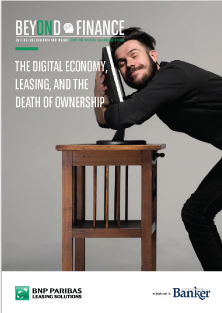By tristan watkins, ceo, bnp paribas leasing solutions UK
Does the allure of ownership outweigh its burdens? In an increasingly digital world – where little of what you buy is ever more than five years from relative obsolescence – it’s a particularly relevant question.
Equipment, machinery, software; these things can cost a lot of money, and their value depreciates from the moment of purchase. Where software is concerned, you never really own it at all: you buy the right to use it on a perpetual license, and have no proprietary rights.
Consumers and businesses alike are coming to the realisation that to accumulate big purchases is to accumulate future financial and operational liabilities. So instead of buying these items, a significant proportion of businesses are turning to leasing. According to the UK Finance & Leasing Association, leasing accounted for 32% of overall investment in machinery, equipment and purchased software in 2015 – constituting a total of £29bn of new finance provided to businesses and the public sector.
So why is leasing so popular with companies – and why now?
Changing preferences
On one level, businesses don’t want to make long-term commitments to products because the wider population isn’t all that interested in making long-term commitments to products.
Where we once rented DVDs for a few days, we now use Netflix and Amazon Prime to access an extensive archive of digital movies, TV shows, and other entertainment. Where access to Adobe’s Creative Suite used to be prohibitively expensive for small businesses, it is now available for a set monthly rate, and on an a la carte basis.
The advent of the subscription economy has changed global perceptions of what value for money is – for consumers and businesses alike.
The benefits of business leasing
Although they do make necessary products and services available to a wider, less-moneyed audience, subscriptions and leases aren’t entirely about affordability.
If you’re a small business owner and you’re purchasing the 2016 version of some SAP enterprise resource planning software, you’re doing so with the foreknowledge that a 2017 version will be coming sooner, and a 2018 version soon after that. You’ve spent hundreds of pounds on something that grows more obsolete with every passing day. Contrast software leasing: when you rent your most essential applications, you can arrange contractual terms that allow for upgrades at regular intervals – not unlike mobile phone upgrades – and for affordable monthly payments.
An outright purchase can also inhibit flexibility and scalability. Companies are often logistically unprepared for growth: if a start-up buys enough desktop PCs for ten people, it doesn’t necessarily anticipate that it may eventually need thirty or a hundred. Finding the money to upscale can be difficult, and if a business hasn’t budgeted for the transition, it may well be forced to remain small. Leasing allows for some degree of flexibility: enabling businesses to upsize with ease.
Finally, leases and subscriptions usually come with some kind of support: the company or the loaning bank is invariably interested in long-term, recurring arrangements, so they’ve every incentive to make sure it works for the full duration of the contract. If a business buys software outright, it typically has to understand how to implement it into their existing systems and how to connect it to other applications. An e-commerce customer whose forklift trucks break down just outside of the warranty period will often be left high and dry. With leases and subscriptions, all the support an organisation could reasonably ask for can be included in the terms of the deal for a nominal fee. This includes initial audit, consultancy, setup, training and implementation, and maintenance.
A new lease of life?
The simplest answer to the question of leasing’s growing popularity is that it’s the most convenient and flexible means of financing equipment, machinery, software, vehicles, and whatever else people might need access to.
Modernity, and all of its tech-facilitated progress, may have accelerated the adoption of subscriptions, but let’s not forget that this model originated in the 17th century – and the fundamentals haven’t necessarily changed all that much. A customer still pays for access to a product up to the point where they no longer want it.
A business that takes out a conventional bank loan to finance a purchase will eventually be left with mounting interest and a depreciating asset. A business that leases products and services will have whatever they need today – and be assured of access to whatever they need tomorrow.
Share post:
Featured in ...

Media contact
Suhale Vorajee
Head of Marketing and Communications
BNP Paribas Leasing Solutions UK
T: 01179 100 895
E: click here





